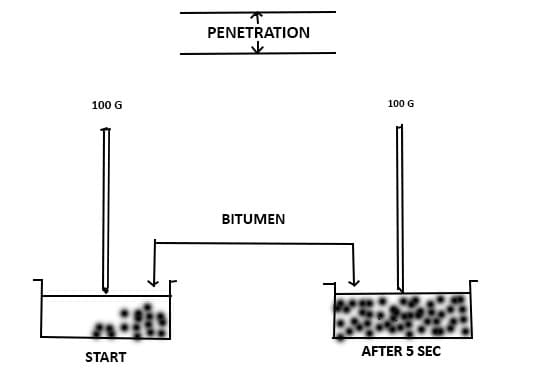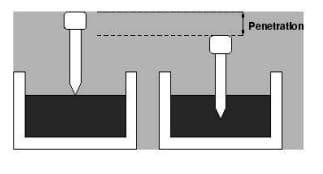

Importance of Penetration Testing
- The penetration test is used as a measure of consistency. Higher values of penetration indicate softer consistency.
- The test is widely used all over the world for classifying bituminous materials into different grades.
- Depending upon the climatic conditions and type of construction, bitumen of different penetration grade are used. Commonly used grades are 30/40, 60/70 and 80/100.
- In warmer regions, lower penetration grades are preferred and in colder regions bitumen with higher penetration values are used.
In different regions and countries, different Standards and Grading systems are used for determining the quality of petroleum bituminous Binders. The most recognized standards for petroleum bitumen are published by
- European Committee for Standardization (CEN)
- Deutsche Industrie Norm (DIN EN)
- Association Française de Normalisation (AFNOR – NF EN)
- BSI Standards – the UK’s National Standards Body (NSB – BS EN)
- American Society for Testing and Materials (ASTM)
- American Association of State Highway and Transportation Officials (AASHTO)
- South African Standard Organization (SABS)
- Standards Australia (AS)
How penetration test is conducted?


Theory and Scope
By measuring the depth in tenths of a millimeter to which a standard loaded needle will penetrate vertically into a sample of the material in 5 seconds under standard conditions of temperature, a penetration test measures the consistency (hardness) of bituminous materials. As can be seen from the figure, penetration testing is understood. This test is used to determine and verify the bitumen’s grade. The test is conducted according to IS 1203 – 1978.
Equipments Required :
- Penetrometer
- A cylindrical container and a needle
- Water bath and bath thermometer
- Transfer dish or Tray
Description of Equipments
- Penetrometer: calibrated to give accurate results in one-tenth of a millimeter allows the needle to penetrate without much friction. Penetrometers are leveled with leveling screws and spirit levels. An assembly of 100 grams needles is secured in a vertical position and weighs 100 grams total. The knob on the needle assembly is used to release or lock it. One-tenth of a millimeter is measured on the dial. With an automatic type penetrometer, the needle is released exactly for 5 seconds by an electric timer.
- Container: is a flat bottomed cylindrical metallic dish 55 mm in diameter and 35 mm in depth. The deeper the dish, the greater the penetration. For penetrations of 25 mm or more, a dish with a diameter of 70 mm and a depth of 45 mm is used.
- Needle: consists of a straight, highly polished, cylindrical hard steel rod.
- Water bath: maintained at 25 degrees Celsius ± 0.1 degree Celsius containing not less than 10 liters of water, the sample is immersed to a depth not less than 100 mm from the top and supported on a perforated shelf not less than 50 mm from the bottom of the bath.
- Bath thermometer: of range 0 to 44 degrees Celsius with 0.2 degree Celsius graduations.
- Time measuring device: with an accuracy of ± 0.1 seconds.


Precaution:
- Wear safety glasses and/or face shields, heat resistant gloves with close-fitting cuffs.
- There shall be no smoking or the presence of other ignition sources in close proximity of test set up.
- Check the samples for the presence of water while the material is still cold. If water is present drain off as much water as possible and allows the sample to dry at room temperature or blow-dry with clean compressed air.
- There should be no movement of the container while the needle is penetrating into the sample.
- Bitumen sample should be just sufficient to fill the container to a depth of at least 15 mm in excess of the expected penetration.
- The needle should be cleaned with benzene and dried before each penetration.
- It is important to maintain the test temperature at the specified level during testing.
Materials
Following materials required test,
- Bitumen of known grade
- Benzene
Procedure
- Soften the material to a pouring consistency by heating it at a temperature not more than 90 degrees Celsius for bitumen and 60 degrees Celsius for tars above the approximate softening point. Stir it thoroughly until it is homogeneous and is free from air bubbles and water.
- Pour the melted bitumen into the container to a depth of at least 15 mm in excess of expected penetration at 25 degrees Celsius.
- Protect the sample from dust and allow it to cool in an atmospheric temperature between 15 degrees Celsius to 30 degrees Celsius for 1 ∼ hour. Then place it in a transfer dish in the water bath at 25 ± 0.1 degrees Celsius for 1 to 1 and a half hours.
- Fill the transfer dish with water from the water bath to depth sufficient to cover the container completely, place the sample in it and keep the container on the stand of the penetration apparatus.
- Clean the needle with benzene, dry it and load with the weight. The total moving load required is 100 ± 0.25 grams. This includes the weight of the needle, carrier and super-imposed weights.
- Adjust the needle to make contact with the surface of the sample. This may be done by placing the needlepoint in contact with its image reflected by the surface of the bituminous material.
- Adjust the pointer of the dial to read zero or note the initial dial reading.
- Release the needle for exactly 5 seconds. The release of the needle can be secured with the help of an automatic electric timer. The needle is locked after 5 seconds, the use of timer minimizes human error.
- Adjust the rack of penetration dial to measure the distance penetrated in one-tenth of a millimeter.
- Repeat the above procedure at least thrice at points on the surface of the sample not less than 10 mm apart and not less than 10 mm from the side of the dish. After each test returns the sample and transfer dish to the water bath and wash the needle clean with benzene and dry it. In the case of the material of penetration greater than 25 mm, three determinations on each of the two identical test specimens using a separate needle for each determination should be made, leaving the needle in the sample on completion of each determination to avoid disturbance of the specimen.
The value of penetration should be the mean of not less than three determinations expressed in tenths of a millimeter.
Conclusion of Penetration Test of Bitumen
By performing the above penetration test on bitumen, we can determine whether the given bitumen sample meets the specification requirements for penetration as given in the standards. Penetration value is one of the measures of the quality of bitumen along with other measures such as ductility value and so on. The penetration value found out by the penetration test of bitumen is compared to the standard value and thus it can be concluded whether the sample meets the penetration criteria.
